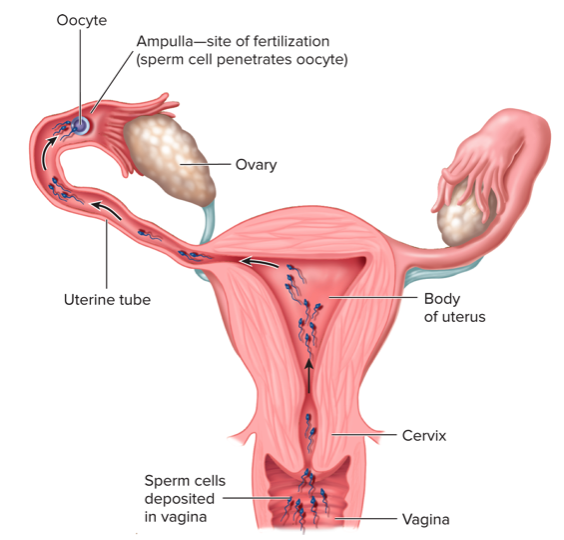embryology I: prenatal development
1/16
There's no tags or description
Looks like no tags are added yet.
Name | Mastery | Learn | Test | Matching | Spaced |
|---|
No study sessions yet.
17 Terms
what are gametes
haploid (23 instead of 46 chromosomes) reproductive cells produced in gonads via meiosis
what are the gonads/gametes for female/male
female - ovaries / oocytes (eggs)
male - testes / sperm cells
ovulation
secondary oocyte (completed 1st meiotic division) released from one of the ovaries 14 days after menstural cycle has begun
how do cells divide during each meiotic division
not equally, resulting in a large cell (oocyte), and a small cell (the polar body)
what happens to the oocyte
it is swept out of ovary into uterine tube (fallopian tube) via finer-like projections into ampulla (widened region)
what happens to the polar body
it gets rid of extra genetic material from steps of meiosis and degrades over time
fertilization
in ampulla within uterine tube, the sperm and oocyte fuse to form a zygote (diploid fertilized egg)
where do the sperm go after ejaculation
20 million in vagina
1% in uterus
100-200 in ampulla
why do few sperm reach oocyte
poor motility and many killed by low pH of female reproductive tract
forces responsible for moving sperm through female reproductive tract
sperm swimming ability (self-propelled by their flagella)
oxytocin released during intercourse + prostaglandins in semen, stimulate muscular contractions in uterus and uterine tubes (enhancing sperm movement)
when can fertilization occur and why
sexual intercourse must occur between 6 days before, and 1 day after ovulation
sperm can be viable in female reproductive tract for up to 6 days, and oocyte can be fertilized for up to 24 hours after ovulation

parts of female reproductive tract
list prenatal period stages
from conception/fertilization until birth; germinal, embryonic, fetal periods
germinal period
fertilization to 14 days (first 2 weeks)
primitive germ layers form (will become body tissues)
embryonic period
weeks 3-8
major organ systems develop
called an ‘embryo’
fetal period
9th week until brith (typically 38 weeks)
organs systems (exist already) grow and become more mature
called ‘fetus’